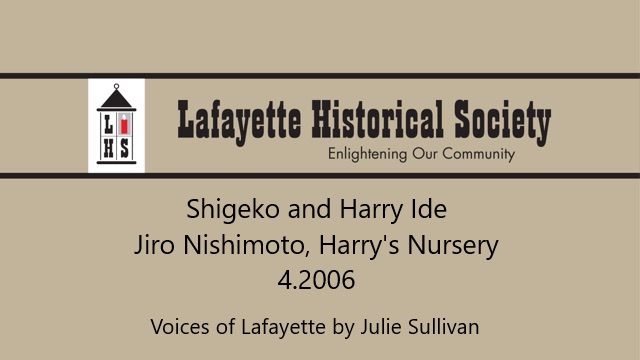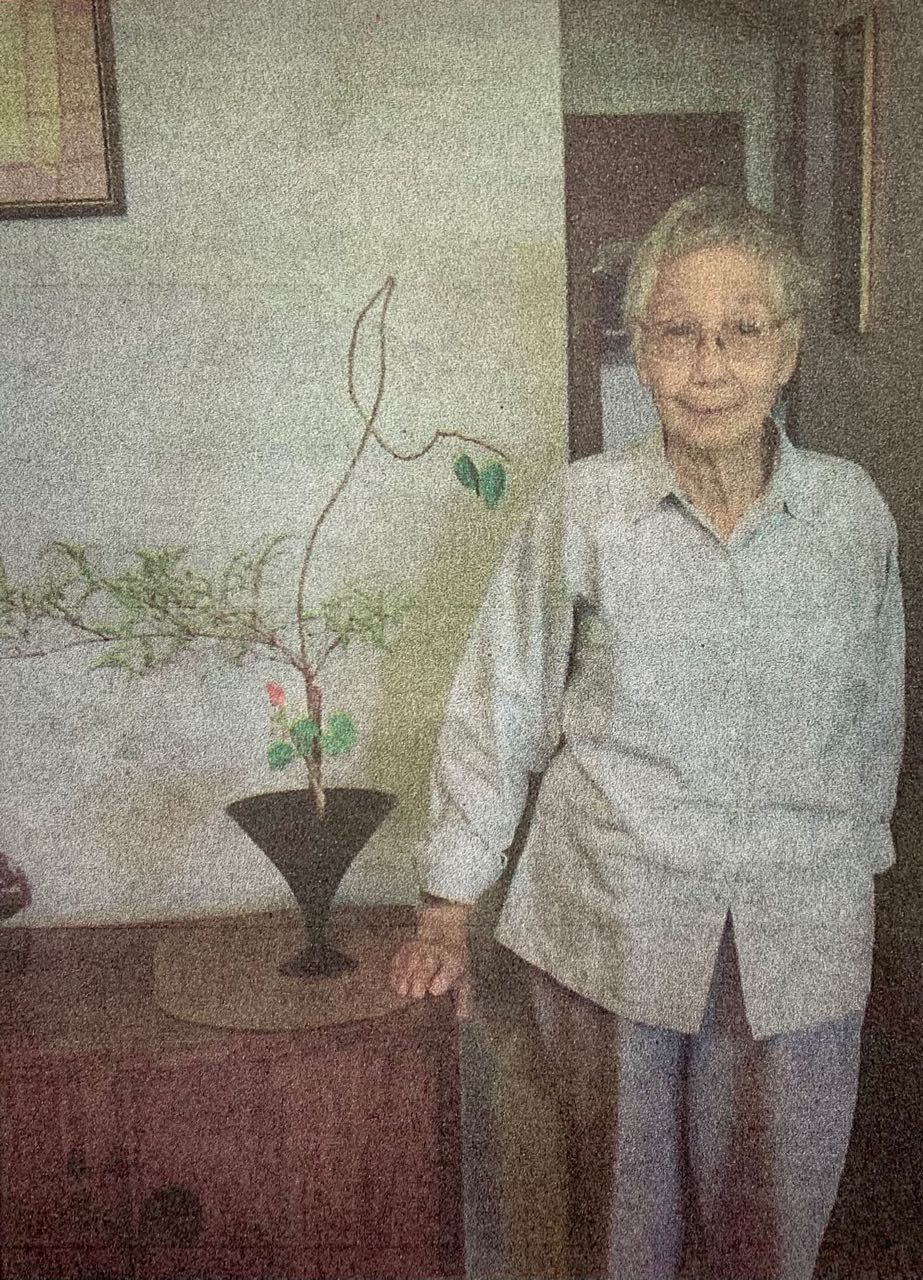Summary:
Shigeko Ide and Jiro Nishimoto were interviewed by Julie Sullivan in April, 2006. Harry’s Nursery, which had been founded over 50 years earlier by Shigeko and her late husband Harry, was thriving under the management of Jiro Nishimoto. Jiro had begun working at the nursery as a teenager and had been careful to continue the practices, philosophy, and ideals of the business’s founders.
Oral History:
Harry’s Nursery, nestled between two automotive shops on a quarter acre parcel just west of the Lafayette Park Hotel, is a testament to one man’s and one woman’s vision. Masaji ‘Harry’ Ide and his wife, Shigeko, started the business more than fifty years ago. Although Harry retired in 1981, Jiro Nishimoto has carried the vision on. The nursery was recently honored by the Chamber of Commerce as Lafayette’s oldest operating member.
“He was a pioneer,” Jiro says of Harry, who passed away in 1995. “Harry’s Japanese name means honest and true,” his widow, Shigeko, explains. “And he followed through with his name. He didn’t charge to advise people on their landscape. When someone would say, ‘I need twenty plants,’ Harry would ask how many feet he had, and many times Harry would tell the customer, ‘You don’t need that many.’ He was that honest.
“Harry read philosophy and believed in what he read. He was a self-made man. He gave many students their first jobs and acted as a mentor to many young people. He encouraged and helped people start their own businesses. The CEO of Kaiser and the head of the Oakland Historical Society always used to stop by to talk to Harry when they were in town. He could talk to anybody.
“My husband always took the purchases and put them in the car for the ladies,” Shigeko remembers with a smile. “He always took care of the ladies, perhaps because he was surrounded by women. There were nine kids in his family, and only two were boys. He was the older.”
Harry, born in Alamo on Christmas Day, 1911, was taken to Japan as an infant. “Both his parents had to work,” Shigeko explains. “It was common to take the infants to Japan to have grandmas take care of them.” When he was twelve, Harry returned to the United States and lived with his uncle in Concord. When he was a schoolboy, the family he was rooming with nicknamed him Harry, and the name stuck. At the outbreak of World War II Harry, by then the operator of a growing landscaping business, was looking for a bride.
Shigeko (whose maiden name was Akajita) had completed two years of junior college and was working in Sacramento, when she received a phone call from her mother to come home to Stockton for the weekend and meet an eligible man. “In those days there were very few of us second generation Japanese, and parents would find a bride for their sons,” Shigeko remembers. “But I didn’t want to get married. I was only twenty, and I wanted to continue my education. I thought Harry was too old for me, too. He was twenty-eight, and in those days that was old. But it turned out I couldn’t have picked a better man.”
In the aftermath of Pearl Harbor, Japanese Americans were required to get permission from the government to travel more than fifty miles. “We got permission to go to Reno where we were married in 1942,” she says. “Later we had our wedding reception at Harry’s uncle’s house in Concord.” Soon after the Ides were married, they received a notice they would be evacuated. (In March, 1942, an Executive Order signed by the President excluded all persons of Japanese ancestry from living in much of the West Coast. Eventually ten relocation centers would be established in the Western states and the Army would forcibly move approximately 100,000 evacuees, most American citizens. Although the majority of the evacuees were Japanese, other nationalities including Germans and Italians were also interned or relocated.)
“My husband didn’t want me separated from my family, so soon after our marriage he moved his business to Stockton. He wanted to be sure I was in the same camp with my parents. We had to give up everything when we left. My parents had a grocery store in Stockton they had to give up. There was nobody to take over. We took what we could carry with two hands,” she remembers.
From the Stockton Fairgrounds, where they were interned temporarily, the family was sent to Arkansas. “Then they gave us this questionnaire asking if we were loyal to the United States,” she says. “There was no question if we were loyal. We were born and raised here, but they doubted us, so we had to answer yes or no. If you put no, you were shipped to a camp in Tule Lake. Harry wanted to get back to California to take care of his mother, so he answered ‘no,’ and I had to answer ‘no’ so we wouldn’t be separated. Our friends said, ‘Harry, you are more American than any American here.’”
Shigeko remembers “fences and people with guns” at Tule Lake. She was pregnant when they arrived, and her two oldest daughters were born in the camp. “There were only Japanese doctors, no dentists. When I had my babies, there was no anesthesia. There were two factions in the camp, one that wanted to go back to Japan. Harry’s friend asked him to become treasurer of this group, and because of that, Harry was taken away to Texas. I had to have my second baby without him.” After about four years Shigeko returned to Stockton with her parents and her two young daughters. “Harry and I didn’t get back together for a while even after the war was over, but he was finally released.”
The Ides came to Walnut Creek around 1950. Shigeko did housework for a family that owned a piano store on Mt. Diablo Boulevard in Walnut Creek, and Harry maintained their garden in exchange for rent. Harry also did independent landscaping. “That was the only thing available,” she explains.
“Harry must have been born with an appreciation of reading,” she remembers fondly. “He always visited second-hand bookstores, and went to night school. He had cartons of books.” After receiving an inheritance from the sale of his uncle’s house, Harry bought the property on Mt. Diablo Boulevard in Lafayette and opened the nursery. “We had three kids at the time,” she remembers, “and we lived in the house on the back of the lot. It was a thousand square feet.”
At first Harry bought plants on consignment from a Japanese nursery. “That’s how we got started,” she explains. “We worked six days. One day we had to close so we could go buy groceries.” Eventually the Ides had four daughters, all of whom graduated from Acalanes High School and earned degrees from California colleges. “We sent all four girls to college, because Harry always said education is something you can not lose.” Shigeko has eight grandchildren, one who just became a lawyer and one who plans to become a doctor.
After ten years of living on the nursery property, the Ides bought a home a few blocks away, where Shigeko still lives. “One of our customers was Johnson Clark, the builder. We had looked at other houses but could not get them. We encountered discrimination. But since we knew Johnson as a customer, he gave us first choice of the four houses on our street.”
Shigeko has been teaching Ikebana, Japanese flower arranging, in her home for 35 years. She took classes in Oakland and has also studied in Japan. When she and Harry were operating the nursery, she taught on her day off or at night.
In 1974, Jiro Nishimoto came to work at the nursery. Even after Jiro bought the business in 1981, Shigeko and Harry continued working there part time for several years. Today the nursery is open six days a week, with longer hours in spring and summer.
Jiro, who graduated from Humboldt State University with a B.S. in Fisheries, was born in San Francisco. He worked for the Division of Fish and Wildlife for seven years, part of the time in Alaska and part on fishing vessels on the high seas. For a short while, he worked for the state Agriculture Department, then came to the nursery in answer to an employment ad. “I was very green,” he says with a wry smile. “Harry was my mentor.”
Jiro’s brother, Sab, joined him at the nursery in the late 70’s. The third employee is Tom Anderson who has been with the nursery nearly 20 years.
“When I started in 74 we used to sell a lot of junipers,” Jiro says, “but you don’t see many anymore. There are fewer oleanders. People today are interested in organic fertilizers. Today many other kinds of stores carry plants, but we stress service and quality. Lafayette people want to shop locally. I enjoy watching the maples through the seasons, their color in fall, and I like boxwood hedges,” he says.
Jiro remembers commuting from his home in Berkeley to Lafayette “was much easier in 1974. Dr. William Reeves, a well known expert in mosquito abatement who was on the faculty at UC Berkeley, was one of our customers.”
He remembers when Sun Valley Lumber stood where the Park Hotel is today. “There was a furniture store on the other side of the auto shop next to us. Across the street was the Western Sand and Gravel yard, and between the nursery and the 7-11 was a store called Down the Garden Path that sold African violets. Windy Hill Nursery used to be on Old Tunnel Road, just after you turned left on Pleasant Hill Road,” he recalls.
Jiro used to drive to the flower market in San Francisco every Friday morning to pick up violets and azaleas. “I used to get there by 3:00 a.m. so I could get back to the nursery by 7:00 a.m. Now I call a grower. Even though I put in sixty hours a week, it didn’t seem like work because I was thinking and ordering part of the time. And it got easier with time. I got more relaxed.”
Excerpted from “Voices of Lafayette” by Julie Sullivan. This book is available for purchase in the History Room.



The history of the Ide family seems unbelievable, what they went through and how they overcame adversity. I have so much respect for them.
Agree! Toki Ide was in my class at Stanley and Acalanes. Sadly, never knew the story of her family till now.
David, Toki says hello! I am her son in law (Danny) and my cousin in Walnut Creek saw this article and sent me the link. Toki prefers to write letters and does not currently have a computer or smartphone so I called her and read her this article and the comments. She remembered you right away and wanted me to say hello.
Danny–That’s so nice of you to message me. Hello back to you and Toki. We’re getting old! (smile emoji). Take care. I remember she and Lynnae Fraumeni were friends at school.
My name is Linda (Messinger) Robinson and Dawn (Sumi) Ide was my best friend growing up. I am trying to find her…..are you able to help?
This is a fabulous story about a great and hard working family that persevered…and succeeded against very tough odds. An American Classic really. We all know and remember driving by Harry’s for many years. I also fondly remember Sun Valley Lumber and the Furniture store. Thank you for this great piece of history.